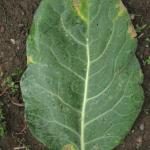Brassicas, Black Rot
Xanthomonas campestris pv. campestris
Black rot, caused by Xanthomonas campestris pv. campestris is one of the most devastating diseases of cruciferous crops and can result in high losses of yield and quality. It occurs worldwide and infects all brassica species. (Note: there are other ‘black rot’ diseases, on other crop families, that are not caused by the same pathogen.) This disease can be seed-borne, so prevention begins with purchase of disease-free seed and/or hot water treatment of seed. The UMass Extension program offers hot water treatment of seed (see Hot Water Seed Treatment info page).
Identification:
Symptoms can appear at any growth stage as yellow, V-shaped lesions that extend toward the base of the leaf resulting in wilt and necrosis. Blackening of veins within lesions and adjacent areas is a diagnostic feature of this pathogen. Symptoms of black rot can be similar to those of drought stress, overwatering, or excessive fertilizer application, so identification confirmation from a diagnostician is important.
The pathogen may move into the petiole and spread up the stem or into the roots and become systemic. As the disease progresses, the veins of infected tissues turn black and the normal flow of water and nutrients is impeded. Symptoms on root crops may not be visible on foliage, but blackened veins appear in the roots. On heading crops, infection may spread into the leaves of the head. Black Rot is often followed by invasion by soft-rotting organisms.
Life Cycle:
Xanthomonas campestris pv. campestris is a bacterium that blocks the water-conducting tissue of the plant with xanthan, a mucilaginous sugar. Its most important means of transmission is on seed; as little as 0.03% infection can cause epidemics. Infested seed and transplants give the pathogen the ability to travel long distances. Symptoms may not appear in the seedbed, resulting in infected plants to be transplanted into the field. The pathogen is then spread within a field by splashing water, wind, equipment, people, and insects. Once in a field, disease development is favored by warm temperatures. The pathogen may move from the leave into the petiole and spread up the stem or into the roots and become systemic. As the disease progresses, the veins of infected tissues turn black and the normal flow of water and nutrients is impeded. Symptoms on root crops may not be visible on foliage, but blackened veins appear in the roots. On leaf crops, infection may spread into the leaves of the head. Black rot is often followed by invasion of soft-rotting organisms. The bacteria can persist alone in the soil for 40-60 days and on infected plant debris for up to two years. X. campestris pv. campestris can be spread long distances by infested seeds and transplants. The optimum temperature for the pathogen to grow is from 80ºF to 86ºF. Water, in the form of either rain or dew, is required for the disease to establish and grow.
Cultural Controls & Prevention:
- Select seed that has been certified as disease-free.
- Treat seed with hot water to eradicate the bacteria. Treat seed for 15- 30 minutes at 50° C, dry, and test for germination. This process must be done carefully and it is recommended that a small sample of seed be tested for the effect on germination first. UMass offers a hot water seed treatment service – click here for more information.
- Fumigate or steam sterilize soil in seedbeds and use clean, sterilized seed flats.
- Avoid planting in areas that receive run-off from areas previously planted to crucifers.
- Increase spacing between plants to decrease leaf wetness period and likelihood of infection.
- Monitor transplants and promptly remove and destroy infected seedlings.
- Do not trim seedlings, as the bacteria are easily spread by contaminated tools.
- Practice a three year rotation and control cruciferous weeds.
- Do not work in fields when they are wet and avoid overhead irrigation.
- Do not locate cull piles near fields or storage areas.
- Promptly incorporate crop residues after harvest to speed decomposition.
- Bactericides are only marginally effective; sanitation and environmental management are important disease management principles.
Chemical Controls & Pesticides:
Copper products may be effective in preventing disease when used before plant is infected and with continued sprays at 7-10 day intervals after symptoms develop. Ensure coverage of lower leaf surfaces.
For Current information on disease recommendations ins specific crops including information on chemical control & pesticide management, please visit the New England Vegetable Management Guide website.
Crops that are affected by this disease:
--M. Bess Dicklow, R. Hazzard, A. Cavanagh, S. Scheufele, UMass Extension
The Center for Agriculture, Food and the Environment and UMass Extension are equal opportunity providers and employers, United States Department of Agriculture cooperating. Contact your local Extension office for information on disability accommodations. Contact the State Center Director’s Office if you have concerns related to discrimination, 413-545-4800 or see ag.umass.edu/civil-rights-information.


